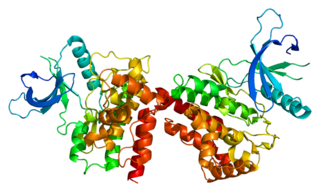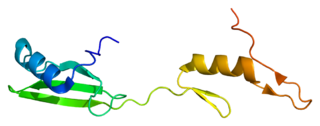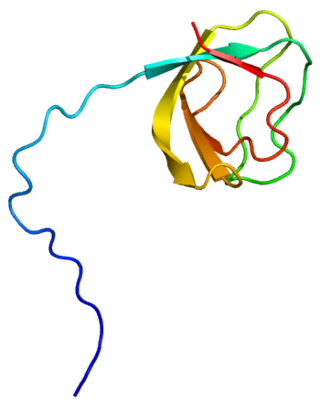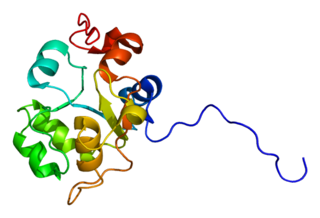Growth factor receptor-bound protein 7, also known as GRB7, is a protein that in humans is encoded by the GRB7 gene. [5] [6]
Growth factor receptor-bound protein 7, also known as GRB7, is a protein that in humans is encoded by the GRB7 gene. [5] [6]
The product of this gene belongs to a small family of adaptor proteins that are known to interact with a number of receptor tyrosine kinases and signaling molecules. This gene encodes a growth factor receptor-binding protein that interacts with epidermal growth factor receptor (EGFR) and ephrin receptors. The protein plays a role in the integrin signaling pathway and cell migration by binding with focal adhesion kinase (FAK). Alternative splicing results in multiple transcript variants encoding different isoforms, although the full-length natures of only two of the variants have been determined to date. [5]
GRB7 is an SH2-domain adaptor protein that binds to receptor tyrosine kinases and provides the intra-cellular direct link to the Ras proto-oncogene. Human GRB7 is located on the long arm of chromosome 17, next to the ERBB2 (alias HER2/neu) proto-oncogene.
These two genes are commonly co-amplified (present in excess copies) in breast cancers. GRB7, thought to be involved in migration, [5] is well known to be over-expressed in testicular germ cell tumors, esophageal cancers, and gastric cancers.
GRB7 has been shown to interact with:

The insulin receptor (IR) is a transmembrane receptor that is activated by insulin, IGF-I, IGF-II and belongs to the large class of receptor tyrosine kinase. Metabolically, the insulin receptor plays a key role in the regulation of glucose homeostasis; a functional process that under degenerate conditions may result in a range of clinical manifestations including diabetes and cancer. Insulin signalling controls access to blood glucose in body cells. When insulin falls, especially in those with high insulin sensitivity, body cells begin only to have access to lipids that do not require transport across the membrane. So, in this way, insulin is the key regulator of fat metabolism as well. Biochemically, the insulin receptor is encoded by a single gene INSR, from which alternate splicing during transcription results in either IR-A or IR-B isoforms. Downstream post-translational events of either isoform result in the formation of a proteolytically cleaved α and β subunit, which upon combination are ultimately capable of homo or hetero-dimerisation to produce the ≈320 kDa disulfide-linked transmembrane insulin receptor.

The epidermal growth factor receptor is a transmembrane protein that is a receptor for members of the epidermal growth factor family of extracellular protein ligands.

Growth factor receptor-bound protein 2, also known as Grb2, is an adaptor protein involved in signal transduction/cell communication. In humans, the GRB2 protein is encoded by the GRB2 gene.

Adapter molecule crk also known as proto-oncogene c-Crk is a protein that in humans is encoded by the CRK gene.

The RETproto-oncogene encodes a receptor tyrosine kinase for members of the glial cell line-derived neurotrophic factor (GDNF) family of extracellular signalling molecules. RET loss of function mutations are associated with the development of Hirschsprung's disease, while gain of function mutations are associated with the development of various types of human cancer, including medullary thyroid carcinoma, multiple endocrine neoplasias type 2A and 2B, pheochromocytoma and parathyroid hyperplasia.

Janus kinase 2 is a non-receptor tyrosine kinase. It is a member of the Janus kinase family and has been implicated in signaling by members of the type II cytokine receptor family, the GM-CSF receptor family, the gp130 receptor family, and the single chain receptors.

PTK2 protein tyrosine kinase 2 (PTK2), also known as focal adhesion kinase (FAK), is a protein that, in humans, is encoded by the PTK2 gene. PTK2 is a focal adhesion-associated protein kinase involved in cellular adhesion and spreading processes. It has been shown that when FAK was blocked, breast cancer cells became less metastatic due to decreased mobility.

Tyrosine-protein kinase HCK is an enzyme that in humans is encoded by the HCK gene.

Phospholipase C, gamma 1, also known as PLCG1 and PLCgamma1, is a protein that in humans involved in cell growth, migration, apoptosis, and proliferation. It is encoded by the PLCG1 gene and is part of the PLC superfamily.

Crk-like protein is a protein that in humans is encoded by the CRKL gene.

Rap guanine nucleotide exchange factor 1 is a protein that in humans is encoded by the RAPGEF1 gene.

Cytoplasmic protein NCK1 is a protein that in humans is encoded by the NCK1 gene.

Signal transducing adapter molecule 2 is a protein that in humans is encoded by the STAM2 gene.

Cytoplasmic protein NCK2 is a protein that in humans is encoded by the NCK2 gene.

SH2 domain-containing adapter protein B is a protein that in humans is encoded by the SHB gene.

Signal transducing adapter molecule 1 is a protein that in humans is encoded by the STAM gene.

SHC-transforming protein 3 is a protein that in humans is encoded by the SHC3 gene.

Ubiquitin carboxyl-terminal hydrolase 8 is an enzyme that in humans is encoded by the USP8 gene.

Growth factor receptor-bound protein 14 is a protein that in humans is encoded by the GRB14 gene.

Mitogen-activated protein kinase 15, also known as MAPK15, ERK7, or ERK8, is an enzyme that in humans is encoded by the MAPK15 gene.